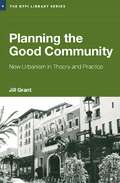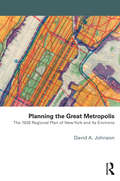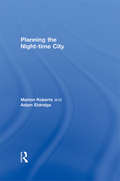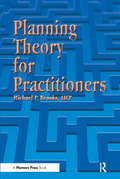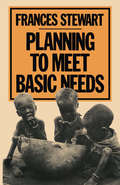- Table View
- List View
Planning the Capitalist City: The Colonial Era to the 1920s
by Richard E. FoglesongStarting with the colonial period, but focusing especially on the Progressive era, Richard Foglesong offers both a narrative account and a theoretical interpretation of urban planning in the United States.Originally published in 1986.The Princeton Legacy Library uses the latest print-on-demand technology to again make available previously out-of-print books from the distinguished backlist of Princeton University Press. These editions preserve the original texts of these important books while presenting them in durable paperback and hardcover editions. The goal of the Princeton Legacy Library is to vastly increase access to the rich scholarly heritage found in the thousands of books published by Princeton University Press since its founding in 1905.
Planning the Good Community: New Urbanism in Theory and Practice (RTPI Library Series)
by Jill GrantAn examination of new urban approaches both in theory and in practice. Taking a critical look at how new urbanism has lived up to its ideals, the author asks whether new urban approaches offer a viable path to creating good communities. With examples drawn principally from North America, Europe and Japan, Planning the Good Community explores new urban approaches in a wide range of settings. It compares the movement for urban renaissance in Europe with the New Urbanism of the United States and Canada, and asks whether the concerns that drive today’s planning theory – issues like power, democracy, spatial patterns and globalisation- receive adequate attention in new urban approaches. The issue of aesthetics is also raised, as the author questions whether communities must be more than just attractive in order to be good. With the benefit of twenty years’ hindsight and a world-wide perspective, this book offers the reader unparalleled insight as well as a rigorous and considered critical analysis.
Planning the Good Community: New Urbanism in Theory and Practice (RTPI Library Series)
by Jill GrantAn examination of new urban approaches both in theory and in practice. Taking a critical look at how new urbanism has lived up to its ideals, the author asks whether new urban approaches offer a viable path to creating good communities. With examples drawn principally from North America, Europe and Japan, Planning the Good Community explores new urban approaches in a wide range of settings. It compares the movement for urban renaissance in Europe with the New Urbanism of the United States and Canada, and asks whether the concerns that drive today’s planning theory – issues like power, democracy, spatial patterns and globalisation- receive adequate attention in new urban approaches. The issue of aesthetics is also raised, as the author questions whether communities must be more than just attractive in order to be good. With the benefit of twenty years’ hindsight and a world-wide perspective, this book offers the reader unparalleled insight as well as a rigorous and considered critical analysis.
Planning the Great Metropolis: The 1929 regional plan of New York and its environs (Planning, History and Environment Series)
by David A. JohnsonAs the Regional Plan Association embarks on a Fourth Regional Plan, there can be no better time for a paperback edition of David Johnson’s critically acclaimed assessment of the 1929 Regional Plan of New York and Its Environs. As he says in his preface to this edition, the questions faced by the regional planners of today are little changed from those their predecessors faced in the 1920s. Derided by some, accused by others of being the root cause of New York City’s relative economic and physical decline, the 1929 Plan was in reality an important source of ideas for many projects built during the New Deal era of the 1930s. In his detailed examination of the Plan, Johnson traces its origins to Progressive era and Daniel Burnham’s 1909 Plan of Chicago. He describes the making of the Plan under the direction of Scotsman Thomas Adams, its reception in the New York Region, and its partial realization. The story he tells has important lessons for planners, decision-makers and citizens facing an increasingly urban future where the physical plan approach may again have a critical role to play.
Planning the Great Metropolis: The 1929 regional plan of New York and its environs (Planning, History and Environment Series)
by David A. JohnsonAs the Regional Plan Association embarks on a Fourth Regional Plan, there can be no better time for a paperback edition of David Johnson’s critically acclaimed assessment of the 1929 Regional Plan of New York and Its Environs. As he says in his preface to this edition, the questions faced by the regional planners of today are little changed from those their predecessors faced in the 1920s. Derided by some, accused by others of being the root cause of New York City’s relative economic and physical decline, the 1929 Plan was in reality an important source of ideas for many projects built during the New Deal era of the 1930s. In his detailed examination of the Plan, Johnson traces its origins to Progressive era and Daniel Burnham’s 1909 Plan of Chicago. He describes the making of the Plan under the direction of Scotsman Thomas Adams, its reception in the New York Region, and its partial realization. The story he tells has important lessons for planners, decision-makers and citizens facing an increasingly urban future where the physical plan approach may again have a critical role to play.
Planning the Mobile Metropolis: Transport for People, Places and the Planet (Planning, Environment, Cities)
by Luca BertoliniOur economic welfare and social well-being depend on our mobility. But our means of travel threaten the planet's sustainability. In this innovative text, Luca Bertolini shows how mobility planning - which takes seriously the demands of both urban and transport planning - offers solutions to transport challenges in the 21st Century.
Planning the Night-time City
by Marion Roberts Adam EldridgeThe night-time economy represents a particular challenge for planners and town centre managers. In the context of liberalised licensing and a growing culture around the '24-hour city', the desire to foster economic growth and to achieve urban regeneration has been set on a collision course with the need to maintain social order. Roberts and Eldridge draw on extensive case study research, undertaken in the UK and internationally, to explain how changing approaches to evening and night-time activities have been conceptualised in planning practice. The first to synthesise recent debates on law, health, planning and policy, this research considers how these dialogues impact upon the design, management, development and the experience of the night-time city. This is incisive and highly topical reading for postgraduates, academics and reflective practitioners in Planning, Urban Design and Urban Regeneration.
Planning the Night-time City
by Marion Roberts Adam EldridgeThe night-time economy represents a particular challenge for planners and town centre managers. In the context of liberalised licensing and a growing culture around the '24-hour city', the desire to foster economic growth and to achieve urban regeneration has been set on a collision course with the need to maintain social order. Roberts and Eldridge draw on extensive case study research, undertaken in the UK and internationally, to explain how changing approaches to evening and night-time activities have been conceptualised in planning practice. The first to synthesise recent debates on law, health, planning and policy, this research considers how these dialogues impact upon the design, management, development and the experience of the night-time city. This is incisive and highly topical reading for postgraduates, academics and reflective practitioners in Planning, Urban Design and Urban Regeneration.
Planning the Paris 2024 Olympic and Paralympic Games (Mega Event Planning)
by Marie Delaplace Pierre-Olaf SchutThis book is the first volume to provide a comprehensive account of mega-event planning for the Paris 2024 Olympic and Paralympic Games. It offers a useful summary of the themes and debates relating to urban planning for the Paris Olympics, based on the results of a research programme (Observatory for Research on Mega-Event) funded by Gustave Eiffel University and Paris Est University and partly carried out with the organisers of the Games and their stakeholders. The authors address all aspects of the bidding process, the organisation of the Games and the construction of the social legacy of the Games.
Planning Theory
by Philip AllmendingerThis popular text provides a wide-ranging and up-to-date analysis of planning theories, how these relate to planning practice, and their significance. The third edition has been revised and updated throughout, and features an increased internationalization of coverage and two additional chapters on post-structuralist approaches.
Planning Theory: From the Political Debate to the Methodological Reconstruction
by Franco ArchibugiPlanning Theory expresses a sound unease about the direction taken by the current analysis and criticism of planning experiences. To oppose the debate that freezes planning as a permanently declining engagement, this book aims to identify the essential guidelines of a re-launch of planning processes and techniques, configuring a kind of neo-discipline. This builds upon a multi-disciplinary integration - never seen and experimented with until now.
Planning Theory: A Search for Future Directions
by Robert BurchellTheory and practice in city planning have never been known for their compatibility. The planner, dealing with stresses such as the personalities at work in a board meeting and coping with the realities of fund raising, political realities, and the like, can find little guidance in the theory of the trade. The issues of poverty groups, whether rural or urban, the provision of services, and the packaging of them are seemingly insuperable. The sheer frustration in the inability to deliver, which so many planners feel, can result in considerable impatience and a questioning of the relevance of theory.The editors argue that this state of affairs, though understandable, is unacceptable. While short-range meliorismwithout sense of perspective may be good for the practitioner's individual psyche, the cost may be borne by the long-run best interests of the groups to be served. The risks of a lack of perspective and the experiences generated by this phenomenon are too serious in their implications to permit the process to continue.In this new age of anxiety it is essential for both planners and theorists to understand their roles as well as provide guidance in shaping them. Burchell and Sternlieb have thus gathered here a variety of individuals, all of whom in their separate and distinct fashions are seasoned, both in practice and in theory. The book is divided into five sections: Physical Planning in Change, Social Planning in Change, Public Policy Planning in Change, Economic Planning in Change, and a final section detailing the roles of planners and who they are. These shared puzzlements and insights will prove useful to all practitioners and theorists in the planning field.
Planning Theory: A Search for Future Directions
by Robert W. BurchellTheory and practice in city planning have never been known for their compatibility. The planner, dealing with stresses such as the personalities at work in a board meeting and coping with the realities of fund raising, political realities, and the like, can find little guidance in the theory of the trade. The issues of poverty groups, whether rural or urban, the provision of services, and the packaging of them are seemingly insuperable. The sheer frustration in the inability to deliver, which so many planners feel, can result in considerable impatience and a questioning of the relevance of theory.The editors argue that this state of affairs, though understandable, is unacceptable. While short-range meliorismwithout sense of perspective may be good for the practitioner's individual psyche, the cost may be borne by the long-run best interests of the groups to be served. The risks of a lack of perspective and the experiences generated by this phenomenon are too serious in their implications to permit the process to continue.In this new age of anxiety it is essential for both planners and theorists to understand their roles as well as provide guidance in shaping them. Burchell and Sternlieb have thus gathered here a variety of individuals, all of whom in their separate and distinct fashions are seasoned, both in practice and in theory. The book is divided into five sections: Physical Planning in Change, Social Planning in Change, Public Policy Planning in Change, Economic Planning in Change, and a final section detailing the roles of planners and who they are. These shared puzzlements and insights will prove useful to all practitioners and theorists in the planning field.
Planning Theory for Practitioners
by Michael BrooksThis book is recommended reading for planners preparing to take the AICP exam. In this new book, the author bridges the gap between theory and practice. The author describes an original approach-Feedback Strategy-that builds on the strengths of previous planning theories with one big difference: it not only acknowledges but welcomes politics-the bogeyman of real-world planning. Don't hold your nose or look the other way, the author advises planners, but use politics to your own advantage. The author admits that most of the time planning theory doesn't have much to do with planning practice. These ideas rooted in the planner's real world are different. This strategy employs everyday poltiical processes to advance planning, trusts planners' personal values and professional ethics, and depends on their ability to help clients articulate a vision. This volume will encourage not only veteran planners searching for a fresh approach, but also students and recent graduates dismayed by the gap between academic theory and actual practice.
Planning Theory for Practitioners
by Michael BrooksThis book is recommended reading for planners preparing to take the AICP exam. In this new book, the author bridges the gap between theory and practice. The author describes an original approach-Feedback Strategy-that builds on the strengths of previous planning theories with one big difference: it not only acknowledges but welcomes politics-the bogeyman of real-world planning. Don't hold your nose or look the other way, the author advises planners, but use politics to your own advantage. The author admits that most of the time planning theory doesn't have much to do with planning practice. These ideas rooted in the planner's real world are different. This strategy employs everyday poltiical processes to advance planning, trusts planners' personal values and professional ethics, and depends on their ability to help clients articulate a vision. This volume will encourage not only veteran planners searching for a fresh approach, but also students and recent graduates dismayed by the gap between academic theory and actual practice.
Planning to Care: Regulation, procedure and practice under the Children Act 1989 (PDF)
by Roger Grimshaw Ruth SinclairIn England and Wales, the Children Act 1989 introduced a comprehensive regulatory framework for planning and reviewing the care of young people who are looked after by local authorities. Planning to Care examines how the quality and effectiveness of planning practice in both rural and urban settings was reshaped, drawing on the views of young people and their parents as well as practitioners. The book evaluates the outcomes of the Children Act's 'regulatory strategy' and makes recommendations for improvements. This ebook will an invaluable reference for social workers, teachers, health professionals and policy makers concerned with children, as well as anyone wishing to assess the effects of statutor regulation upon social care.
Planning to Fail: The US Wars in Vietnam, Iraq, and Afghanistan (Bridging the Gap)
by James H. LebovicThe United States national-security establishment is vast, yet the United States has failed to meet its initial objectives in almost every one of its major, post-World War II conflicts. Of these troubled efforts, the US wars in Vietnam (1965-73), Iraq (2003-11), and Afghanistan (2001-present) stand out for their endurance, resource investment, human cost, and miscalculated decisions. Because overarching policy goals are distant and open to interpretation, policymakers ground their decisions in the immediate world of short-term objectives, salient tasks, policy constraints, and fixed time schedules. As a consequence, they exaggerate the benefits of their preferred policies, ignore the accompanying costs and requirements, and underappreciate the benefits of alternatives. In Planning to Fail, James H. Lebovic argues that a profound myopia helps explain US decision-making failures. In each of the wars explored in this book, he identifies four stages of intervention. First and foremost, policymakers chose unwisely to go to war. After the fighting began, they inadvisably sought to extend or expand the mission. Next, they pursued the mission, in abbreviated form, to suboptimal effect. Finally, they adapted the mission to exit from the conflict. Lebovic argues that US leaders were effectively planning to fail whatever their hopes and thoughts were at the time the intervention began. Decision-makers struggled less than they should have, even when conditions allowed for good choices. Then, when conditions on the ground left them with only bad choices, they struggled furiously and more than could ever matter. Policymakers allowed these wars to sap available capabilities, push US forces to the breaking point, and exhaust public support. They finally settled for terms of departure that they (or their predecessors) would have rejected at the start of these conflicts. Offering a far-ranging and detailed analysis, this book identifies an unmistakable pattern of failure and highlights lessons we can learn from it.
Planning to Fail: The US Wars in Vietnam, Iraq, and Afghanistan (Bridging the Gap)
by James H. LebovicThe United States national-security establishment is vast, yet the United States has failed to meet its initial objectives in almost every one of its major, post-World War II conflicts. Of these troubled efforts, the US wars in Vietnam (1965-73), Iraq (2003-11), and Afghanistan (2001-present) stand out for their endurance, resource investment, human cost, and miscalculated decisions. Because overarching policy goals are distant and open to interpretation, policymakers ground their decisions in the immediate world of short-term objectives, salient tasks, policy constraints, and fixed time schedules. As a consequence, they exaggerate the benefits of their preferred policies, ignore the accompanying costs and requirements, and underappreciate the benefits of alternatives. In Planning to Fail, James H. Lebovic argues that a profound myopia helps explain US decision-making failures. In each of the wars explored in this book, he identifies four stages of intervention. First and foremost, policymakers chose unwisely to go to war. After the fighting began, they inadvisably sought to extend or expand the mission. Next, they pursued the mission, in abbreviated form, to suboptimal effect. Finally, they adapted the mission to exit from the conflict. Lebovic argues that US leaders were effectively planning to fail whatever their hopes and thoughts were at the time the intervention began. Decision-makers struggled less than they should have, even when conditions allowed for good choices. Then, when conditions on the ground left them with only bad choices, they struggled furiously and more than could ever matter. Policymakers allowed these wars to sap available capabilities, push US forces to the breaking point, and exhaust public support. They finally settled for terms of departure that they (or their predecessors) would have rejected at the start of these conflicts. Offering a far-ranging and detailed analysis, this book identifies an unmistakable pattern of failure and highlights lessons we can learn from it.
Planning Under Pressure
by John Friend Allen HicklingPlanning under Pressure offers managers, planners, consultants and students a comprehensive and authoritative guide to the Strategic Choice Approach, which has gradually been attracting worldwide recognition as a fresh, versatile and practical approach to collaborative decision-making under uncertainty. Starting from basic principles, the book uses helpful diagrams and clear explanations to demonstrate practical ways of approaching daunting decision problems; of devising possible ways forward; and of working effectively towards agreed courses of action. Along he way, decision makers are helped to cope with diverse sources of uncertainty – technical, political, managerial – in a strategic manner.In this extended third edition, the authors have added short contributions from 21 users from seven countries. These new contributors present lessons from their varied experiences in adapting the Strategic Choice Approach to guide decision-making and learning in settings ranging from the re-routing of a controversial city carnival procession to national policy for the management of nuclear waste.
Planning Under Pressure
by John Friend Allen HicklingPlanning under Pressure offers managers, planners, consultants and students a comprehensive and authoritative guide to the Strategic Choice Approach, which has gradually been attracting worldwide recognition as a fresh, versatile and practical approach to collaborative decision-making under uncertainty. Starting from basic principles, the book uses helpful diagrams and clear explanations to demonstrate practical ways of approaching daunting decision problems; of devising possible ways forward; and of working effectively towards agreed courses of action. Along he way, decision makers are helped to cope with diverse sources of uncertainty – technical, political, managerial – in a strategic manner.In this extended third edition, the authors have added short contributions from 21 users from seven countries. These new contributors present lessons from their varied experiences in adapting the Strategic Choice Approach to guide decision-making and learning in settings ranging from the re-routing of a controversial city carnival procession to national policy for the management of nuclear waste.
Planning Urban Places: Self-Organising Places with People in Mind
by Mary GanisUrban change is often difficult because we are dealing with people’s elusive notions of place and perception, time and change. Urban design and planning in a changing urban context so that it remains relevant for people is elusive because the idea of place is embedded in memory and identity – but whose memory and whose identity? This book seeks to understand the urban change dynamic so that the planning of urban places aligns with the dynamic of people’s perception of place. Planning Urban Places examines the premise that building cities is a concrete business surrounded by a shifting context. It discusses the notion of urban design and placemaking from the perspective of place perception and cognitive psychology, place philosophy and human geography. It also considers network theory to help illustrate the self-organising paradigm of small word network theory for planning urban places.
Planning Urban Places: Self-Organising Places with People in Mind
by Mary GanisUrban change is often difficult because we are dealing with people’s elusive notions of place and perception, time and change. Urban design and planning in a changing urban context so that it remains relevant for people is elusive because the idea of place is embedded in memory and identity – but whose memory and whose identity? This book seeks to understand the urban change dynamic so that the planning of urban places aligns with the dynamic of people’s perception of place. Planning Urban Places examines the premise that building cities is a concrete business surrounded by a shifting context. It discusses the notion of urban design and placemaking from the perspective of place perception and cognitive psychology, place philosophy and human geography. It also considers network theory to help illustrate the self-organising paradigm of small word network theory for planning urban places.
Planning with Complexity: An Introduction to Collaborative Rationality for Public Policy
by Judith E. Innes David E. BooherIn an era of rapid change, uncertainty, and hyperpartisanship, when wicked problems abound, tools for solving public problems are more essential than ever. The authors lay out a new theory for collaborative practice in planning, public administration, and public policy. Planning with Complexity provides both theoretical underpinnings and extensive case material on collaboration and offers ways of understanding and conducting effective practice. Collaborative rationality means collaboration that is inclusive, informed, grounded in authentic dialogue, and that results in wise and durable outcomes. The scholar-practitioner author team builds on more than 40 years of research, teaching, and practice addressing environmental issues, housing, and transportation. This second edition updates the case studies and adds new examples reflecting the global spread of collaborative practices. It builds on insights that have recently emerged in the literature. More than 75 new references have been incorporated, along with new tables. This book is essential for students, educators, scholars, and reflective practitioners in public policy fields in the 21st century.
Planning with Complexity: An Introduction to Collaborative Rationality for Public Policy
by Judith E. Innes David E. BooherIn an era of rapid change, uncertainty, and hyperpartisanship, when wicked problems abound, tools for solving public problems are more essential than ever. The authors lay out a new theory for collaborative practice in planning, public administration, and public policy. Planning with Complexity provides both theoretical underpinnings and extensive case material on collaboration and offers ways of understanding and conducting effective practice. Collaborative rationality means collaboration that is inclusive, informed, grounded in authentic dialogue, and that results in wise and durable outcomes. The scholar-practitioner author team builds on more than 40 years of research, teaching, and practice addressing environmental issues, housing, and transportation. This second edition updates the case studies and adds new examples reflecting the global spread of collaborative practices. It builds on insights that have recently emerged in the literature. More than 75 new references have been incorporated, along with new tables. This book is essential for students, educators, scholars, and reflective practitioners in public policy fields in the 21st century.

